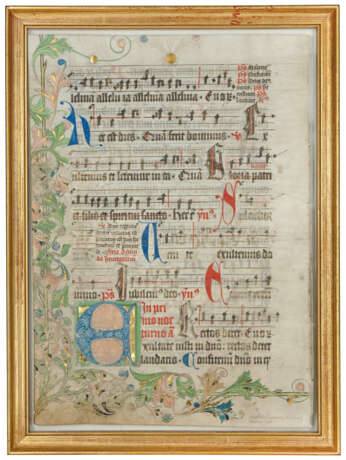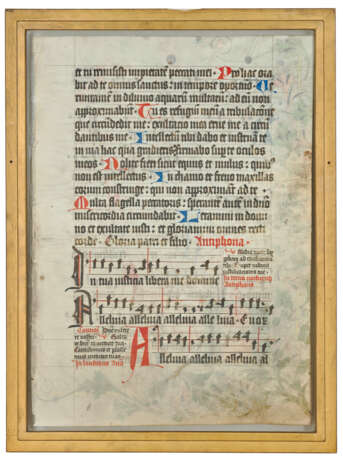ID 1105675
Lot 21 | Matthias Hartung (copyist)
Estimate value
£ 3 000 – 5 000
Historiated initial ‘E’ on a leaf from a Choir Psalter, in Latin, illuminated manuscript on vellum, Würzburg, 1499.
A handsome illuminated leaf with lively decoration, from a Choir Psalter made for the Benedictine Abbey of St Stephen in Würzburg in 1499, copied by Matthias Hartung, the second part of which is now at the Beinecke, Yale University.
486 x 352mm. Up to 23 lines of text, music in Hufnagel notation, the illuminated initial 'E' opening the antiphon 'Exultate iusti in domino rectos', ornate 2-sided floral border, strapwork initials with red highlights, other large initials alternately in red or blue, smaller capitals stroked in red, rubrics in red (some marginal cropping). In a double-sided frame.
Provenance:
(1) Copied in Würzburg at and for the Benedictine Abbey of St Stephen, founded in 1057 by Archbishop Adalbero. The Abbey was closed under the secularisation of 1803 and its library was either absorbed into local institutions or dispersed on the open market. A sister volume to the parent manuscript from which this leaf comes contains a dedication inscription providing date, provenance and the name of the scribe, and is now at Yale University, Beinecke Library, Ege 549.1983. Our manuscript was designated HL 42 in Scott Gwara's corpus of Ege manuscripts (Otto Ege's Manuscripts: A Study of Ege’s Manuscript Collections, Portfolios, and Retail Trade, with a Comprehensive Handlist of Manuscripts Collected or Sold, 2013, 133). Gwara traces 31 of 43 sets of fragments from Ege's portfolios, a single leaf at Missouri State University and three leaves offered at Bloomsbury Auctions, 7 December 2020. For the line of provenance of this manuscript and its sister volume at Beinecke, see S. Gwara, 'The Scribe and Provenance of Otto F. Ege's Choir Psalter from the Abbey of St Stephen, Würzburg, Date 1499 (Gwara HL 42)', Fragmentology, IV, 2021, pp.79-93.
(2) Leander van Ess (1772-1847), famous book collector, monk, priest and Professor of Theology at the University of Marburg. Van Ess was a prolific acquirer of monastic books: in 1821 he bought 136 of the manuscripts from the Charterhouse of St Barbara in Cologne at auction, through Heberle and Lempert; he also bought printed books from from the Dominicans of Warburg and from Huysberg and Hadmersleben Abbeys, among others (see M. McC. Gatch, 'The Book Collections and the Library of Leander van Ess', So Precious a Foundation, at pp.56-58). These two manuscripts ('partes duae') were described in his catalogue of 1823, Sammlung und Verzeichniss handscriftlicher [sic] Bücher aus dem viii. ix. x. xi. xii. xiii. xiv Jahrhundert, etc., p.48.
(3) Sir Thomas Phillipps (1792-1872): his MS 680, described in his 1837 Catalogus Librorum Manuscriptorum, p.8, no 680. Phillipps bought his mss 387-759, 4480, 6833-5 from Leander van Ess in 1824.
(4) Sotheby's, 1 December 1947, lot 109. According to the catalogue, the two parts of the Choir Psalter totalled 265 leaves and contained '30 large initial letters finely executed in gold and colours with well designed borders illuminated in the South German manner, with animals, birds and grotesques'.
(5) Otto Ege (1888-1951). The Beinecke volume contains 114 leaves, and is apparently textually complete. Gwara (2021, p.82) suggests that the manuscript from which our leaf comes was probably dismembered due to its poorer state of preservation than the Beinecke volume, but only after Otto Ege's death, by his wife.
The illumination is typical of Würzburg book production of the time. The inscription on the Beinecke volume names Matthias Hartung as the scribe. We know that Hartung copied liturgical books from c.1460-1499: in 1481, he copied a Psalter for the Abbey of Sts Peter and Paul near Erfurt, while his earliest recorded work is a copy of Caesarius of Heisterbach's Dialogus miraculorum, now in Würzburg, Universitätsbibliothek, M.ch.f.246 (see Gwara, 2021, p.84).
| Address of auction |
CHRISTIE'S 8 King Street, St. James's SW1Y 6QT London United Kingdom | ||||
|---|---|---|---|---|---|
| Preview |
| ||||
| Phone | +44 (0)20 7839 9060 | ||||
| Buyer Premium | see on Website | ||||
| Conditions of purchase | Conditions of purchase |




